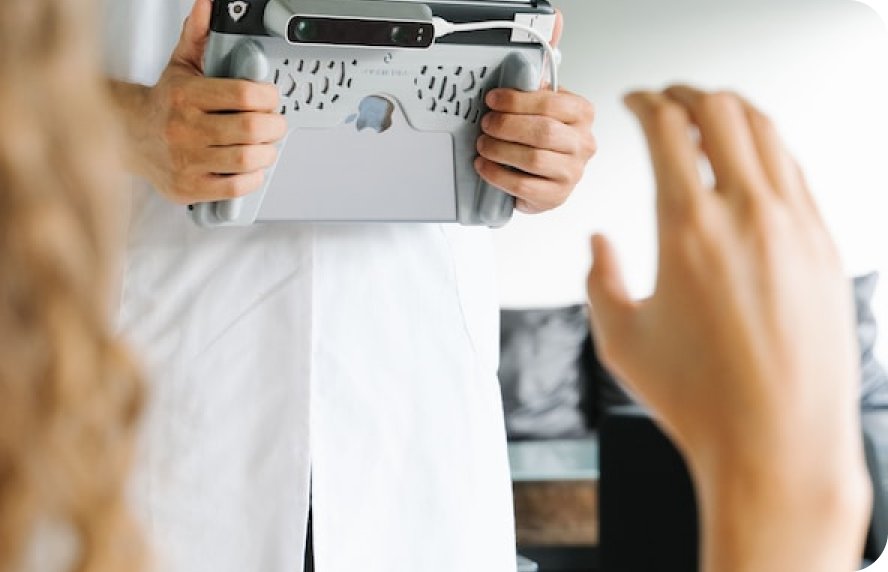Barcode Audit – Understanding the barcodes in your business before you start
Barcode Datalink recommends that you perform a ‘barcode audit’ before you start implementing any sort of barcode printing or scanning solution. You need to know what barcodes you do have already coming in from suppliers and what they say.
If ‘barcode audit’ to you means you want to do a ‘stocktake’ using barcodes, then click here on ‘Stocktakes Online‘ to learn more about our SaaS Stocktake Software system.

To make your warehouse functions run the most efficiently every product and bin location should be barcoded.
Here are some real life examples and the results of a barcode audit we did for a potential customer.
Questions we need to answer:
- How many products do we stock?
- How many of them come with a barcode?
- How many suppliers do we have?
- Which suppliers are barcoding their products?
- Are their entire range of products barcoded or only some of them?
- What does the barcode say?
- What types of barcodes are they printing?
- Does the human readable match the barcode?
To find out how many SKU’s (Stock Keeping Units) you carry should be a simple matter of checking your accounting or ERP system.
How many come with a barcode? If you are Woolworths or Coles the answer should be 100% of them. If you are new to barcoding then its time to spend sometime in the warehouse taking a look.
The background to this example is that the customer is a large multi-national. The warehouse in Sydney stocks several thousand parts and a lot of them have a ‘barcode’. Most products come in from overseas and a small percentage are purchased locally and the Australian suppliers have ‘barcoded’ the products for us. All this sounds very promising.
With my customer I spent a few hours in the warehouse walking around and taking photos. This is what we found:
Label 1.
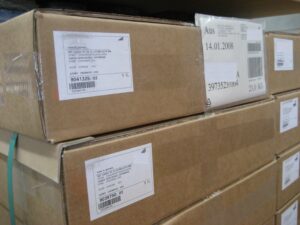
These cartons are all barcoded. Above and below the Code 128 barcode is human readable text. Scanning the barcode revealed that it contains ‘903975002’.
The text above the barcode is ‘9039750. 02’.
Since this barcode matches the customers internal part number this can be scanned as is. This carton contains one unit of the product.
An important point to note about this pallet is that it is mixed. Therefore on goods receiving each carton needs to be scanned in a systematic approach to make sure nothing is missed or scanned twice. Our advice is to scan from top to bottom and left to right. The configuation of this pallet is 6 high and 2 wide on the front face of the pallet and the same again on the rear side. Therefore 24 cartons have to be scanned to receive in this pallet.
Label 2.
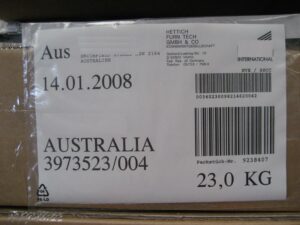
This label is providing an SSCC (Serial Shipping Container Code) in an EAN-128 barcode (top) and a package number below.
If your software allows you to record these details when receiving then scan these barcodes.
Label 3.
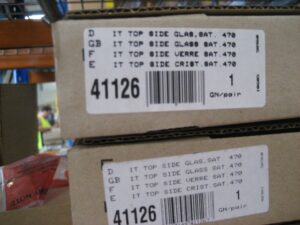
In the above example the customer immediately identified that ‘41126’ is their part number for this product.
The barcode is an EAN-13 and has thirteen digits that are ‘9323149411267’. As we can see, the ‘41126’ is in the barcode as the last five digits before the final digit in the EAN which is the check digit.
To use this barcode when scanning, it must be linked in the ERP software to the part number. The best way to do this is to use a hand held mobile computer to key in the part number ‘41126’ and find the part. Then add the alternate part number ‘9323148411267’ and save the updated record.
If you cannot do this then there are three other options:
1. ask your supplier if they can provide you a file that cross references their part number with your part number
The file they send you could be an Excel of CSV file and would look like:
Sample Excel or CSV file
| Supplier Part Number | Our Part Number |
| 9323149411267 | 41126 |
| 9323149300005 | 30000 |
2. take the part to a PC and call up the part number, then either key in or using a barcode scanner, scan the EAN-13 into the alternate part number field in your ERP system
3. write this information down while at the bin location and later key it in. This is the least favourable method since it is hand writing and typing and very error prone.
Label 4.
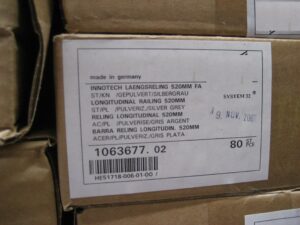
This label looks very similar to label 1. The difference here is that this carton contain 80 units of the product and not just one item.
When receiving in this item if this product ALWAYS comes in 80 units per carton and the ERP system knows that, then scanning this barcode is all this is required.
However, if the carton quantity can vary, then the operator will have to key in the count after scanning the barcode. The operator has to pay more attention and read the label carefully before proceeding.
Label 5.
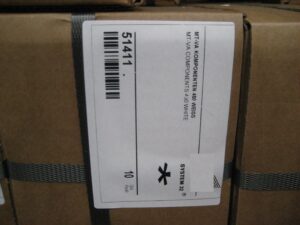
This label has the customer part number clearly visible as ‘51411’. Scanning the barcode revealed data containing ‘51411’. For this product the carton quantity is 10 units.
Over time your staff would learn to recognise the three or four barcode symbologies used in the distribution channel.
This barcode can be scanned as is and relates directly to the part number without an alternative reference.
Label 6.
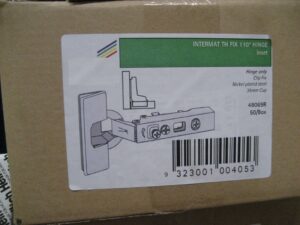
On first glance when the customer saw this nice label he recognised that ‘48069’ without the ‘R’ on the end was their part number. Based on the rule discovered from label 3 it would be assumed that the EAN-13 would contain ‘48069’ within the barcode, ie: ’93 23149 48069 0′ – but on closer inspection it is a different number.
In this example, ‘9323001004053’ needs to be linked to the customers part number using one of the three options discussed above under label 3’s notes.
Label 7.
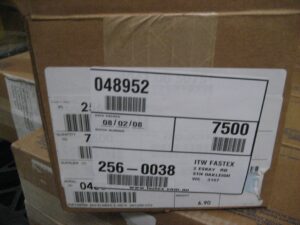
Here is a label from an Australian supplier which is quite useful since an unopened carton has 7500 units and a barcode has been printed containing that information. This could be scanned during a stocktake or movement saving the operator from having to key that in.
However, the barcode for the part number has a leading ‘0’. The customer has to add ‘048952’ as an alternate part number to their database against ‘48952’.
Label 8.
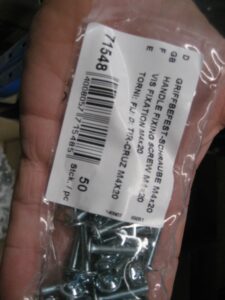
This EAN-13 barcode follows the rule from label 3. The part number ‘71548’ is contained within the barcode. Again this number ‘4008057715485’ will need to be recorded as the alternate part number in the ERP system.
Label 9.
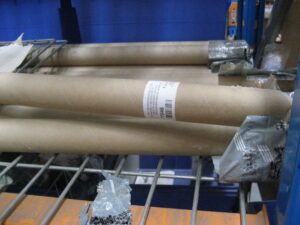
The barcode sticker has been wrapped around a tube. Luckily the mobile computer can still scan this barcode since it is short enough to still be within view. Again, the part number is part of the EAN barcode. Adding the EAN to the database is all that is needed to make use of this barcode.
Label 10.
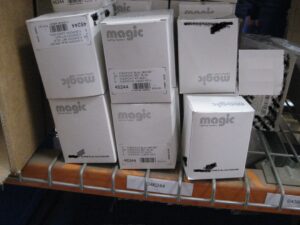
This product is labelled clearly with the part number ‘46244’ and an EAN-13 barcode that contains the part number. Adding ‘4023149462443’ to the alternate part number field allows this barcode to be scanned.
Label 11.
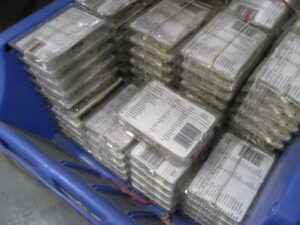
This is a pre-packaged product with an EAN-13 barcode. It does not have the customers five digit code printed anywhere. The thirteen digit number needs to be added to the database.
Motorola scanners do not have any problems reading through clear plastic packaging such as this. However, the elastic band might need to be moved out of the way though.
Label 12.
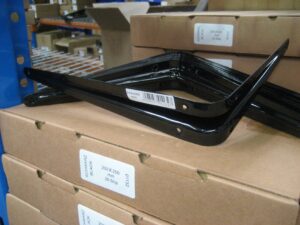
This was one product we found that technically does have a barcode on it but the problem is you have to open the box to scan it. The label on the box has the customer part number ‘01132’.
Results
Products without Barcodes
There were some products that came into the warehouse from various suppliers that had no barcode. A label might have been printed or hand written that included a part number. The customer was advised to approach the suppliers and ask them to attach a barcoded label on incoming goods.
For those that refused to comply for whatever reason, the customer was advised to generate their own labels for incoming goods. While this takes time the benefits flowed down the line for other functions within the warehouse such as stock taking and order picking.
Products with Barcodes
The main task was to physically check each product and capture the alternate part number that was printed as a barcode and relate that to each customer part number. While this is a time consuming task in reality it only takes a few staff several weeks of systematically going around the warehouse with a mobile computer to capture this data and update the ERP system in real time. Click here for information on how to complete this task with batch equipment.
Summary
As a general comment I have found that the source of the labels, ie in this case, the parent company where the products are manufactured, from the start are poorly advised with regards to barcode product labelling.
First of all there was an overall lack of consistency in numbering and then labelling the products. The EAN numbering system if implemented correctly should work globally and from manufacturer to retailer and all should be able to use the same barcodes.
There should be no need for everyone to call the same thing something different just because you have handled it. If the manufacturer is sending you a part with an EAN-13 barcode on it, use that code as your part number. Don’t invent something else and call it XYZ-123. If you do, you have to cross reference it.
For the customer above, my recommendations were to ask the parent company to look at making all labelling consistent. To use the EAN-13 barcode on all outer packaging and to make sure if the 5 digit code was printed that it matched within the thirteen digits.
Secondly, that the barcode was on the outside package so staff don’t have to open the package to scan the barcode (see label 12 comments).
For pallets of the same product for the supplier to print and apply a pallet label that contains the part number and quantity. Using the EAN-128 numbering system one barcode can contain both pieces of information. That would mean the receiving party can simply scan one barcode and capture both bits of information.
More importantly, an EAN-13 should not be used on a carton unless it is the same unit of measure as the retail unit – which means, it is the retail unit.
This means that if you have a light globe, for example, and you sell the globe to a consumer via a retail store and the EAN-13 is ‘9310779300005’, then the barcode for a carton will different. Since the carton might contain 12 globes as a trade unit. Having a different barcode for the trade unit means that when you scan the ‘outer’ barcode you know (your computer system should know) that the carton contains 12 x the single unit.
Each trade unit should have a different barcode. So a 24 pack box should be different again.
Single retail unit 9310779300005
Carton of 12
| Quantity | Barcode |
| 1 | 9310779300005 |
| 12 | 19310779300002 |
| 24 | 29310779300003 |
Related Information:
Selection Guide to selecting the right mobile device for your staff & business
Mobile Computers for Men to see what mobile computers men prefer to use in the warehouse
Mobile Computers for Women to see what women prefer
Scanner Types to read about the different type of barcode scan engines available
Keyboard Maps to see the various keyboard options for each mobile computer
Weight Comparison of all the mobile computers
Pocket Controller Pro How to take control of your mobile computer remotely
DataWedge Add barcode, RFID & RS-232 capabilities to your Motorola mobile
AppCenter How to lock down a Motorola mobile computer with Appcenter
Click here to Contact Us For more information or pricing, call us on (02) 9636-5299







